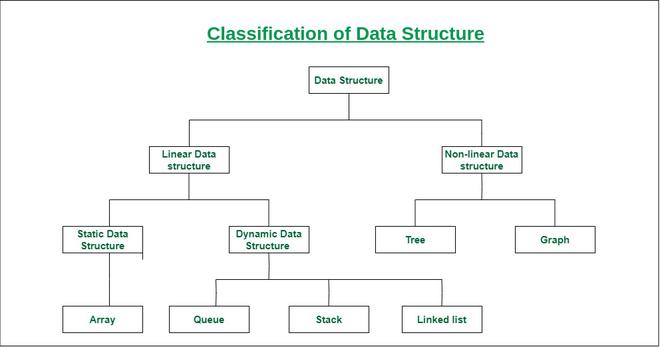Different Types of Data Structures

There are several types of data structures, each with its own characteristics and use cases. Here are some of the most common types:
-
Primitive Data Types: These are the basic data types provided by programming languages, such as integers, floating-point numbers, characters, and boolean values.
-
Linear Data Structures:
- Arrays: Contiguous memory locations used to store elements of the same type.
- Linked Lists: Elements are stored in nodes, each containing a reference to the next node in the sequence.
- Stacks: Follows the Last In, First Out (LIFO) principle, where elements are inserted and removed from the same end.
- Queues: Follows the First In, First Out (FIFO) principle, where elements are inserted at the rear and removed from the front.
-
Non-linear Data Structures:
- Trees: Hierarchical data structures consisting of nodes connected by edges. Examples include binary trees, binary search trees, AVL trees, and B-trees.
- Graphs: Represented by a set of vertices (nodes) connected by edges (links). Graphs can be directed or undirected and can have cycles.
- Heaps: Specialized tree-based data structures used to maintain a collection of elements with a specific ordering property.
-
Hash-based Data Structures:
- Hash Tables: Data structures that use a hash function to map keys to their corresponding values. Hash tables offer efficient insertion, deletion, and retrieval operations.
-
Advanced Data Structures:
- Tries (Prefix Trees): Tree-based data structures used to store a dynamic set of strings or keys with associated values.
- Disjoint Sets (Union-Find): Data structures used to represent a collection of disjoint sets and perform operations such as union and find efficiently.
-
Composite Data Structures:
- Graphs with Adjacency Lists or Matrices: Representing graphs using other data structures like arrays or linked lists.
- Trees with Parent Pointers: Trees where each node has a reference to its parent node in addition to child nodes.
These are just a few examples of data structures, and there are many variations and combinations based on specific needs and problem requirements. Choosing the right data structure is essential for designing efficient algorithms and building robust software systems.
Thank you,
